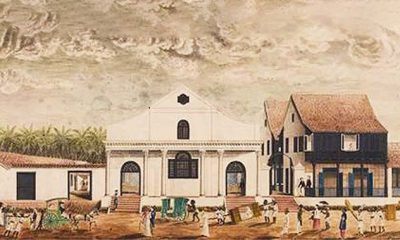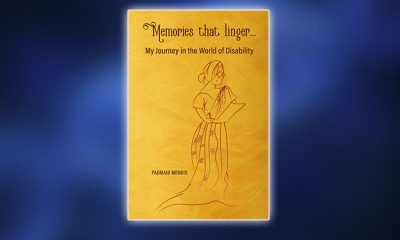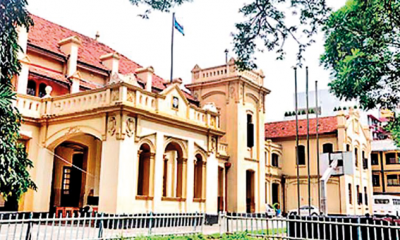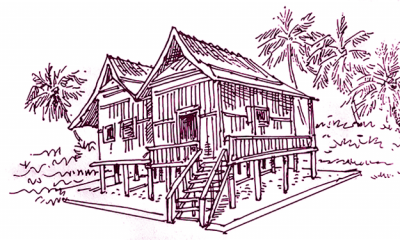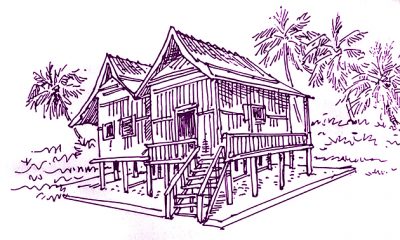Features
A time for reflection: what was achieved and remains to be achieved

(Concluding instalment of Padmani Mendis’ autobiography focused on her global work on Community Based Rehabilitation of the disabled that took her to many parts of the world)
These are my memories as I have lived them. Memories of opportunities that came to me in many parts of the world including my own, to touch the lives of disabled people, their families and their communities. Reading my memories again as I have recalled them for you, I see that, by and large, they are mostly good and happy memories. Am I an optimist in pessimistic times?
Or is it that, while I journeyed, any hopelessness that I may have experienced on my journey in disability has now, in my memory, been overtaken by what was made possible for disabled people? Made possible by facing head on the challenges of introducing change in a world resistant to change. Made possible by the people I met and worked with on my journey who were unafraid to venture into the unknown.
I recall the happy times and times filled with hope I spent in Yemen, in Syria, in Palestine and in Lebanon not so long ago. Seeing flowers blossom for disabled people there. I have written elsewhere about my experiences in these and in other countries. Some like these four countries have since been embroiled in conflict. Many are in a varying state of disorder and ruin.
This includes equally times filled with hope – times spent in Venezuela and in Iran, countries facing economic disaster as is my own. The flowers that bloomed for disabled people in such countries may now be scarce, or may have faded or even gone completely. In other countries that I have described in my memories, flowers blossom, flowers of vivid colours. Seeds are spread and take root. And yet more flowers bloom.
I fear not for those countries where hope has waned or faded. This is but temporary. Globally, a positive pathway for disabled people has been cleared through Community Based Rehabilitation (CBR). Seeds lie dormant. The world we live in goes round and round. And with those cycles, opportunities for disabled people that have faded will blossom and come round again. With economic and social rebirth those seeds that lie dormant will germinate and grow. Other good times will come in time for disabled people everywhere. And there will be many to help them on their way.
In the departure lounge: from memories to permanence
And now I have come to settle down in what would be my departure lounge on the final leg of my journey. Some of those steps I have described more recently were taken from here, my present home. These have added continuity to my journey. And with that continuity they have also created, in my departure lounge, a sense of permanence.
One aspect of that permanence is personal. It comes from the fact that my lounge is situated in my home in an Apartment Block which a property developer had named Prince Alfred Tower (PAT). It is located in Alfred House Gardens.
I would like for a moment to take you back to the earliest memories I shared with you, that concerning my heritage. Alfred House was the name my mother’s grandfather gave to his home. He had named it Alfred House after Alfred, the Prince of Wales who he had entertained in that house. PAT was built in my great-grandfathers back garden on a small portion of what had been his property. The personal permanence stems from there.
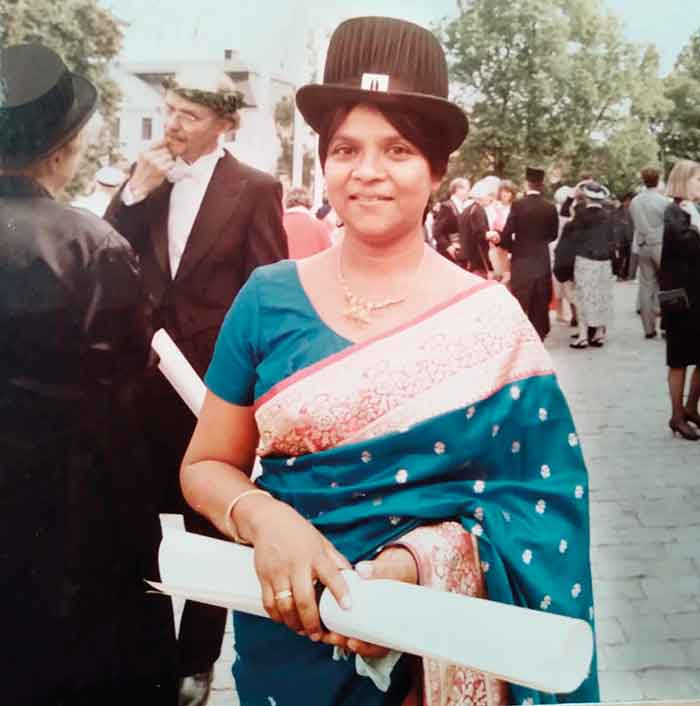
Padmani Mendis after receiving her Honorary Doctorate (Doctor of Medicine Honoris Causa) from the University of Uppsala in Sweden. Honorary degrees in medicine are very rare.
A permanence greater than that however stems from the continuity of the many, many relationships that I have been blessed with all my life, relationships with friends and family. These are deeper than personal if such can be.
These relationships have taken my good fortune out to the world and connected me with all that surrounded me. Many are friendships that have grown from my earliest schooldays to my preparation for a profession; and to my work in that profession in many parts of the globe as in my own. I have made mention of some, but by no means all those friendships.
Here I must add a few to those I have already mentioned. Don Chandrasinghe, who together with his wife Radha, are both also favourite students and among the first I taught. They now live in faraway London. But call me at least every fortnight just to ask how I am doing.
Then there is Camilla Dissanayake, a colleague from the 1970s, who lives but a couple of kilometres away as the crow flies, who will often spend hours on the phone with me talking about the past and the present with some stuff to be sad about and much to laugh about. And Rohana Perera, a student only for a short time, but with whom grew a friendship that has lengthened forever.
More recently has come into my life again Leonie Fernando; she with always a smile on her face and full of laughter; who knew me when she was a student occupational therapist nearly 50 years ago and now in frequent communication. And Sharmini Sinniah, whom I remember I first worked with when she was at Christoffel Blinden Mission or CBM the primary source of support to Disability NGOs; later when she moved to the US Embassy and now continuing that relationship on the phone. All these, permanence.
Then there is the permanence of the work I have contributed to for disabled people, Community Based Rehabilitation. CBR is still evolving and will continue to do so. In the last country I visited, Zambia, I hear that the strategy is now called “CBR for Inclusive Development”. Sounds very promising. I love that terminology.
Come the day, however distant, when disabled people will be completely and comprehensively included as a final and total recognition of their rights, their humanity. Then it will only be one “Development” for all. Not just the words “CBR” but even the word “Inclusive” will be obsolete. Oh, come the day!
A time when every man will be as one,
A time to reach out and touch the sun,
Come the day.
Freedom’s still a thought within your mind,
The fleeting thing that some may never find,
It may still be a million miles away.
Can you hear the bells ringin’?
Voices singin’,
Far away?
Song by the Seekers, 1966
Adding permanence to my work is the recognition of it over the years. I have shared with you my experience of receiving an Honorary Doctorate from the University of Uppsala three decades ago. Seven years ago, the World Confederation of Physical Therapy, WCPT, awarded me the “Leadership in Rehabilitation” award. The award is given every four years, not only to physiotherapists; it is available also to other individuals and organisations who have contributed to international rehabilitation and global health.
And just three years ago, Lincoln College University in Malaysia awarded to me two honorary titles in recognition of my global work – a Professorship and a Doctorate in Physiotherapy. An added honour was that the Vice Chancellor of the University, Prof. Dr. Amiya Bhaumik came to Sri Lanka to award me the two honours himself, personally at a convocation held in Colombo.
And then there is that other permanence which makes life so worthwhile. The Wonderful World that we live in. The beauty of it that is around us.
When I look immediately down from my bedroom window on the seventh floor, I see a multi-coloured sheet of Araliya flowers not once, but twice a year. To the green, green garden beyond comes a kingfisher every morning to perch on a favourite branch and search for possibilities. Perhaps not finding any, it flies away.
Daily a flock of parrots hop from tree to tree, taking cover as it were from those eyes like mine. I believe it is the same flock of parrots that go to my friend Mino’s home perhaps a kilometre away measured on their flight path. She always has for them hanging on her verandah a bowlful of rice and a basin of water. They are there every day as sure as the day follows the night, at ten in the morning and at four in the evening.
And just as sure as it ever is, the two flamboyant trees within my range of vision change themselves into an umbrella of orange every year, in May. Or if they so decide to, they keep us waiting until June or maybe even July.
As I stand at dawn on my balcony with my early morning cup of coffee, on a clear day, I have a beautiful and unique view of the sacred Adams Peak with the sun rising behind it in the east. If I get to the same spot of an evening, I see the sun set behind the western horizon. I stand there transfixed with the beauty of the sky over our coastline at dusk.
Often from the same balcony I have seen soft rainbows lengthen themselves, each in an unending arc with God’s unending promise for tomorrow. Once I was so fortunate as to have seen two rainbows at the same time. A double promise for tomorrow for this our island home. And I believe also for this, our wonderful world.
With all this, what more can I ask for as I journey on at home in my departure lounge. Journey on and wait for His call. Singing with Louis Armstrong the great Satchmo himself,
I see skies of blue
and clouds of white.
The bright blessed day,
the dark sacred night.
And I think to myself
what a wonderful world.
Features
The heart-friendly health minister

by Dr Gotabhya Ranasinghe
Senior Consultant Cardiologist
National Hospital Sri Lanka
When we sought a meeting with Hon Dr. Ramesh Pathirana, Minister of Health, he graciously cleared his busy schedule to accommodate us. Renowned for his attentive listening and deep understanding, Minister Pathirana is dedicated to advancing the health sector. His openness and transparency exemplify the qualities of an exemplary politician and minister.
Dr. Palitha Mahipala, the current Health Secretary, demonstrates both commendable enthusiasm and unwavering support. This combination of attributes makes him a highly compatible colleague for the esteemed Minister of Health.
Our discussion centered on a project that has been in the works for the past 30 years, one that no other minister had managed to advance.
Minister Pathirana, however, recognized the project’s significance and its potential to revolutionize care for heart patients.
The project involves the construction of a state-of-the-art facility at the premises of the National Hospital Colombo. The project’s location within the premises of the National Hospital underscores its importance and relevance to the healthcare infrastructure of the nation.
This facility will include a cardiology building and a tertiary care center, equipped with the latest technology to handle and treat all types of heart-related conditions and surgeries.
Securing funding was a major milestone for this initiative. Minister Pathirana successfully obtained approval for a $40 billion loan from the Asian Development Bank. With the funding in place, the foundation stone is scheduled to be laid in September this year, and construction will begin in January 2025.
This project guarantees a consistent and uninterrupted supply of stents and related medications for heart patients. As a result, patients will have timely access to essential medical supplies during their treatment and recovery. By securing these critical resources, the project aims to enhance patient outcomes, minimize treatment delays, and maintain the highest standards of cardiac care.
Upon its fruition, this monumental building will serve as a beacon of hope and healing, symbolizing the unwavering dedication to improving patient outcomes and fostering a healthier society.We anticipate a future marked by significant progress and positive outcomes in Sri Lanka’s cardiovascular treatment landscape within the foreseeable timeframe.
Features
A LOVING TRIBUTE TO JESUIT FR. ALOYSIUS PIERIS ON HIS 90th BIRTHDAY

by Fr. Emmanuel Fernando, OMI
Jesuit Fr. Aloysius Pieris (affectionately called Fr. Aloy) celebrated his 90th birthday on April 9, 2024 and I, as the editor of our Oblate Journal, THE MISSIONARY OBLATE had gone to press by that time. Immediately I decided to publish an article, appreciating the untiring selfless services he continues to offer for inter-Faith dialogue, the renewal of the Catholic Church, his concern for the poor and the suffering Sri Lankan masses and to me, the present writer.
It was in 1988, when I was appointed Director of the Oblate Scholastics at Ampitiya by the then Oblate Provincial Fr. Anselm Silva, that I came to know Fr. Aloy more closely. Knowing well his expertise in matters spiritual, theological, Indological and pastoral, and with the collaborative spirit of my companion-formators, our Oblate Scholastics were sent to Tulana, the Research and Encounter Centre, Kelaniya, of which he is the Founder-Director, for ‘exposure-programmes’ on matters spiritual, biblical, theological and pastoral. Some of these dimensions according to my view and that of my companion-formators, were not available at the National Seminary, Ampitiya.
Ever since that time, our Oblate formators/ accompaniers at the Oblate Scholasticate, Ampitiya , have continued to send our Oblate Scholastics to Tulana Centre for deepening their insights and convictions regarding matters needed to serve the people in today’s context. Fr. Aloy also had tried very enthusiastically with the Oblate team headed by Frs. Oswald Firth and Clement Waidyasekara to begin a Theologate, directed by the Religious Congregations in Sri Lanka, for the contextual formation/ accompaniment of their members. It should very well be a desired goal of the Leaders / Provincials of the Religious Congregations.
Besides being a formator/accompanier at the Oblate Scholasticate, I was entrusted also with the task of editing and publishing our Oblate journal, ‘The Missionary Oblate’. To maintain the quality of the journal I continue to depend on Fr. Aloy for his thought-provoking and stimulating articles on Biblical Spirituality, Biblical Theology and Ecclesiology. I am very grateful to him for his generous assistance. Of late, his writings on renewal of the Church, initiated by Pope St. John XX111 and continued by Pope Francis through the Synodal path, published in our Oblate journal, enable our readers to focus their attention also on the needed renewal in the Catholic Church in Sri Lanka. Fr. Aloy appreciated very much the Synodal path adopted by the Jesuit Pope Francis for the renewal of the Church, rooted very much on prayerful discernment. In my Religious and presbyteral life, Fr.Aloy continues to be my spiritual animator / guide and ongoing formator / acccompanier.
Fr. Aloysius Pieris, BA Hons (Lond), LPh (SHC, India), STL (PFT, Naples), PhD (SLU/VC), ThD (Tilburg), D.Ltt (KU), has been one of the eminent Asian theologians well recognized internationally and one who has lectured and held visiting chairs in many universities both in the West and in the East. Many members of Religious Congregations from Asian countries have benefited from his lectures and guidance in the East Asian Pastoral Institute (EAPI) in Manila, Philippines. He had been a Theologian consulted by the Federation of Asian Bishops’ Conferences for many years. During his professorship at the Gregorian University in Rome, he was called to be a member of a special group of advisers on other religions consulted by Pope Paul VI.
Fr. Aloy is the author of more than 30 books and well over 500 Research Papers. Some of his books and articles have been translated and published in several countries. Among those books, one can find the following: 1) The Genesis of an Asian Theology of Liberation (An Autobiographical Excursus on the Art of Theologising in Asia, 2) An Asian Theology of Liberation, 3) Providential Timeliness of Vatican 11 (a long-overdue halt to a scandalous millennium, 4) Give Vatican 11 a chance, 5) Leadership in the Church, 6) Relishing our faith in working for justice (Themes for study and discussion), 7) A Message meant mainly, not exclusively for Jesuits (Background information necessary for helping Francis renew the Church), 8) Lent in Lanka (Reflections and Resolutions, 9) Love meets wisdom (A Christian Experience of Buddhism, 10) Fire and Water 11) God’s Reign for God’s poor, 12) Our Unhiddden Agenda (How we Jesuits work, pray and form our men). He is also the Editor of two journals, Vagdevi, Journal of Religious Reflection and Dialogue, New Series.
Fr. Aloy has a BA in Pali and Sanskrit from the University of London and a Ph.D in Buddhist Philosophy from the University of Sri Lankan, Vidyodaya Campus. On Nov. 23, 2019, he was awarded the prestigious honorary Doctorate of Literature (D.Litt) by the Chancellor of the University of Kelaniya, the Most Venerable Welamitiyawe Dharmakirthi Sri Kusala Dhamma Thera.
Fr. Aloy continues to be a promoter of Gospel values and virtues. Justice as a constitutive dimension of love and social concern for the downtrodden masses are very much noted in his life and work. He had very much appreciated the commitment of the late Fr. Joseph (Joe) Fernando, the National Director of the Social and Economic Centre (SEDEC) for the poor.
In Sri Lanka, a few religious Congregations – the Good Shepherd Sisters, the Christian Brothers, the Marist Brothers and the Oblates – have invited him to animate their members especially during their Provincial Congresses, Chapters and International Conferences. The mainline Christian Churches also have sought his advice and followed his seminars. I, for one, regret very much, that the Sri Lankan authorities of the Catholic Church –today’s Hierarchy—- have not sought Fr.
Aloy’s expertise for the renewal of the Catholic Church in Sri Lanka and thus have not benefited from the immense store of wisdom and insight that he can offer to our local Church while the Sri Lankan bishops who governed the Catholic church in the immediate aftermath of the Second Vatican Council (Edmund Fernando OMI, Anthony de Saram, Leo Nanayakkara OSB, Frank Marcus Fernando, Paul Perera,) visited him and consulted him on many matters. Among the Tamil Bishops, Bishop Rayappu Joseph was keeping close contact with him and Bishop J. Deogupillai hosted him and his team visiting him after the horrible Black July massacre of Tamils.
Features
A fairy tale, success or debacle

Sri Lanka-Singapore Free Trade Agreement
By Gomi Senadhira
senadhiragomi@gmail.com
“You might tell fairy tales, but the progress of a country cannot be achieved through such narratives. A country cannot be developed by making false promises. The country moved backward because of the electoral promises made by political parties throughout time. We have witnessed that the ultimate result of this is the country becoming bankrupt. Unfortunately, many segments of the population have not come to realize this yet.” – President Ranil Wickremesinghe, 2024 Budget speech
Any Sri Lankan would agree with the above words of President Wickremesinghe on the false promises our politicians and officials make and the fairy tales they narrate which bankrupted this country. So, to understand this, let’s look at one such fairy tale with lots of false promises; Ranil Wickremesinghe’s greatest achievement in the area of international trade and investment promotion during the Yahapalana period, Sri Lanka-Singapore Free Trade Agreement (SLSFTA).
It is appropriate and timely to do it now as Finance Minister Wickremesinghe has just presented to parliament a bill on the National Policy on Economic Transformation which includes the establishment of an Office for International Trade and the Sri Lanka Institute of Economics and International Trade.
Was SLSFTA a “Cleverly negotiated Free Trade Agreement” as stated by the (former) Minister of Development Strategies and International Trade Malik Samarawickrama during the Parliamentary Debate on the SLSFTA in July 2018, or a colossal blunder covered up with lies, false promises, and fairy tales? After SLSFTA was signed there were a number of fairy tales published on this agreement by the Ministry of Development Strategies and International, Institute of Policy Studies, and others.
However, for this article, I would like to limit my comments to the speech by Minister Samarawickrama during the Parliamentary Debate, and the two most important areas in the agreement which were covered up with lies, fairy tales, and false promises, namely: revenue loss for Sri Lanka and Investment from Singapore. On the other important area, “Waste products dumping” I do not want to comment here as I have written extensively on the issue.
1. The revenue loss
During the Parliamentary Debate in July 2018, Minister Samarawickrama stated “…. let me reiterate that this FTA with Singapore has been very cleverly negotiated by us…. The liberalisation programme under this FTA has been carefully designed to have the least impact on domestic industry and revenue collection. We have included all revenue sensitive items in the negative list of items which will not be subject to removal of tariff. Therefore, 97.8% revenue from Customs duty is protected. Our tariff liberalisation will take place over a period of 12-15 years! In fact, the revenue earned through tariffs on goods imported from Singapore last year was Rs. 35 billion.
The revenue loss for over the next 15 years due to the FTA is only Rs. 733 million– which when annualised, on average, is just Rs. 51 million. That is just 0.14% per year! So anyone who claims the Singapore FTA causes revenue loss to the Government cannot do basic arithmetic! Mr. Speaker, in conclusion, I call on my fellow members of this House – don’t mislead the public with baseless criticism that is not grounded in facts. Don’t look at petty politics and use these issues for your own political survival.”
I was surprised to read the minister’s speech because an article published in January 2018 in “The Straits Times“, based on information released by the Singaporean Negotiators stated, “…. With the FTA, tariff savings for Singapore exports are estimated to hit $10 million annually“.
As the annual tariff savings (that is the revenue loss for Sri Lanka) calculated by the Singaporean Negotiators, Singaporean $ 10 million (Sri Lankan rupees 1,200 million in 2018) was way above the rupees’ 733 million revenue loss for 15 years estimated by the Sri Lankan negotiators, it was clear to any observer that one of the parties to the agreement had not done the basic arithmetic!
Six years later, according to a report published by “The Morning” newspaper, speaking at the Committee on Public Finance (COPF) on 7th May 2024, Mr Samarawickrama’s chief trade negotiator K.J. Weerasinghehad had admitted “…. that forecasted revenue loss for the Government of Sri Lanka through the Singapore FTA is Rs. 450 million in 2023 and Rs. 1.3 billion in 2024.”
If these numbers are correct, as tariff liberalisation under the SLSFTA has just started, we will pass Rs 2 billion very soon. Then, the question is how Sri Lanka’s trade negotiators made such a colossal blunder. Didn’t they do their basic arithmetic? If they didn’t know how to do basic arithmetic they should have at least done their basic readings. For example, the headline of the article published in The Straits Times in January 2018 was “Singapore, Sri Lanka sign FTA, annual savings of $10m expected”.
Anyway, as Sri Lanka’s chief negotiator reiterated at the COPF meeting that “…. since 99% of the tariffs in Singapore have zero rates of duty, Sri Lanka has agreed on 80% tariff liberalisation over a period of 15 years while expecting Singapore investments to address the imbalance in trade,” let’s turn towards investment.
Investment from Singapore
In July 2018, speaking during the Parliamentary Debate on the FTA this is what Minister Malik Samarawickrama stated on investment from Singapore, “Already, thanks to this FTA, in just the past two-and-a-half months since the agreement came into effect we have received a proposal from Singapore for investment amounting to $ 14.8 billion in an oil refinery for export of petroleum products. In addition, we have proposals for a steel manufacturing plant for exports ($ 1 billion investment), flour milling plant ($ 50 million), sugar refinery ($ 200 million). This adds up to more than $ 16.05 billion in the pipeline on these projects alone.
And all of these projects will create thousands of more jobs for our people. In principle approval has already been granted by the BOI and the investors are awaiting the release of land the environmental approvals to commence the project.
I request the Opposition and those with vested interests to change their narrow-minded thinking and join us to develop our country. We must always look at what is best for the whole community, not just the few who may oppose. We owe it to our people to courageously take decisions that will change their lives for the better.”
According to the media report I quoted earlier, speaking at the Committee on Public Finance (COPF) Chief Negotiator Weerasinghe has admitted that Sri Lanka was not happy with overall Singapore investments that have come in the past few years in return for the trade liberalisation under the Singapore-Sri Lanka Free Trade Agreement. He has added that between 2021 and 2023 the total investment from Singapore had been around $162 million!
What happened to those projects worth $16 billion negotiated, thanks to the SLSFTA, in just the two-and-a-half months after the agreement came into effect and approved by the BOI? I do not know about the steel manufacturing plant for exports ($ 1 billion investment), flour milling plant ($ 50 million) and sugar refinery ($ 200 million).
However, story of the multibillion-dollar investment in the Petroleum Refinery unfolded in a manner that would qualify it as the best fairy tale with false promises presented by our politicians and the officials, prior to 2019 elections.
Though many Sri Lankans got to know, through the media which repeatedly highlighted a plethora of issues surrounding the project and the questionable credentials of the Singaporean investor, the construction work on the Mirrijiwela Oil Refinery along with the cement factory began on the24th of March 2019 with a bang and Minister Ranil Wickremesinghe and his ministers along with the foreign and local dignitaries laid the foundation stones.
That was few months before the 2019 Presidential elections. Inaugurating the construction work Prime Minister Ranil Wickremesinghe said the projects will create thousands of job opportunities in the area and surrounding districts.
The oil refinery, which was to be built over 200 acres of land, with the capacity to refine 200,000 barrels of crude oil per day, was to generate US$7 billion of exports and create 1,500 direct and 3,000 indirect jobs. The construction of the refinery was to be completed in 44 months. Four years later, in August 2023 the Cabinet of Ministers approved the proposal presented by President Ranil Wickremesinghe to cancel the agreement with the investors of the refinery as the project has not been implemented! Can they explain to the country how much money was wasted to produce that fairy tale?
It is obvious that the President, ministers, and officials had made huge blunders and had deliberately misled the public and the parliament on the revenue loss and potential investment from SLSFTA with fairy tales and false promises.
As the president himself said, a country cannot be developed by making false promises or with fairy tales and these false promises and fairy tales had bankrupted the country. “Unfortunately, many segments of the population have not come to realize this yet”.
(The writer, a specialist and an activist on trade and development issues . )


